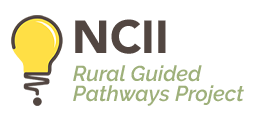“I Couldn’t Have Planned This”
When White Mountains Community College (WMCC) joined the Rural Guided Pathways Project, the college team did not know exactly what to expect. But they were pleased to find a series of experiences that both surprised and motivated them.
“You can’t make this stuff up,” says Charles “Chuck” Lloyd, vice chancellor for the Community College System of New Hampshire and former president of WMCC. “I couldn’t have planned this, but the design of the project created the conditions for incredible things to happen.”
A Paradigm Shift Rooted in Compassion
“Just putting together the team for the Institutes — in particular, being told to bring our state’s employers — changed every discussion we had,” Lloyd recalls. “Instantly it became a community conversation instead of the college team working behind the scenes.”
Thinking about employers as partners from the outset was a paradigm shift, and it changed the way the college team approached the Institutes and their ongoing discussions. Instead of just thinking about WMCC, the team focused on how the college fits into the community.
“It even changed our language,” Lloyd adds. “People outside the college don’t know our lingo, and we realized that if we had to stop and explain ourselves, we were not being clear enough. These changes to everything from our language to our broader lens — all of which started by having our employer as our partner — helped us reinvigorate the work at our college.”
Indeed, WMCC’s employer partner, Mark Bonta, joined the college for all six Rural Guided Pathways Institutes. Bonta is plant manager at Genfoot, the U.S. home of Kamik outdoor footwear. He says the experience of being at the Institutes helped him introduce culture change at his plant.
“At one of the Institutes, I had a moment when I recognized that these community college systems, all in the same place in this large room, are all working from a perspective of compassion — compassion for the student and compassion for community,” Bonta says. “When I originally came into the relationship with WMCC, I was coming from that same perspective. I not only wanted the people in my workforce to improve their occupational skills, but I also wanted to help them reach their personal goals.”
He continues, “At the Institutes, I saw that desire for culture change reflected back to me from the horizon of community college systems across the United States. That was a profound moment for me.”
Training Programs That Benefit the Community
As an employer partner, Bonta was eager to do more than provide advice about workforce needs. He and WMCC had developed some certificate and training programs, and they began to expand them.
“We brought WMCC into our factory to explain how affordable and accessible community college really is and that in some instances employees could get this college education for free,” Bonta says. “And we discussed how we, the employer, might be able to help by allowing people to take an online class while at work in the office.”
Genfoot gives its employees this advice even though their employees may earn degrees that will lead to jobs outside the Genfoot factory. This approach aligns well with the company’s training programs, which benefit the entire community.
Genfoot uses technology that is exclusive to the company’s work so finding mechanics who could diagnose and repair the factory’s machines was challenging. Bonta addressed that problem by developing in-house mechanic training programs and then promoting from within. Over time, the company added leadership training to develop shift leaders.
Ultimately, the company began hiring only entry-level workers and then training existing employees to help them advance into higher-paying jobs. But with the company’s relatively small size, there were not many higher-level jobs.
“Sometimes people got stuck at a lower-wage job because a supervisor had to retire before they could advance,” Bonta says. “I actually started encouraging those people to find higher-paying jobs elsewhere. They learned a lot of skills here in the factory, and now they could go to another place to earn higher wages and salaries.”
“Our approach helps us make sure we have the technical expertise we need, and it is a compassionate way to do things,” Bonta adds. “We’re developing people not only for our own workforce, but for the community as well. We have a lot of factories in our area, and now a lot of them have more competent people than they did before we started doing this training.”
A Partner and a Student
“The training programs were personal for me because I never actually completed my degree,” Bonta explains. “I’ve been plant director here for 20 years, and I had abandoned my degree years ago because I already had the ‘big job.’”
He continues, “But with everything that I had learned in the Institutes, I actually re-enrolled in WMCC as a student. I offered to be the pathways guinea pig so we could find a clear and precise pathway to my goal.”
“How cool is it not only to have an employer with you for the project, but also to turn that employer into a student who follows a pathway?” Lloyd asks. “You couldn’t plan that.”
Seeing Is Believing
The Institutes helped one member of the WMCC team — Nikolaus Nutting — revise his own thinking and then influence large-scale change at the college. Nutting is chair of the Business Department and associate professor of business and accounting. Coincidentally, as a student, Bonta is in Nutting’s department.
Nutting came to the first Institute believing that business and accounting must be taught in a 15-week, traditional format. But by the second Institute, he had seen two relevant presentations from college faculty, one of which included a college president.
“The presenters talked about how their students’ needs have changed and how eight-week terms allow students to focus on a smaller number of classes rather than juggling the deadlines of four or five classes,” Lloyd explains. “And that it isn’t about jamming 15 weeks of content into eight weeks. It’s really a redesign.”
After that experience, Nutting redesigned his own courses, and he now is moving his entire program into eight-week terms. Moreover, other programs at the college are following his lead.
“Faculty members knew that Nick thought it couldn’t be done, but then he came back from the Institute and said, ‘It’s very doable, and here’s why,’” Lloyd recalls. “He is known for doing his research, basing his decisions on data, and being all about his students. Since he does his homework before changing anything and shared all of his data, other faculty were quick to jump on board.”
He adds, “We have seen enrollment growth as well as persistence, retention, and completion growth in those programs.”
Broader Involvement and Student Focus
As the Rural Guided Pathways Project progressed, the WMCC team found that more and more faculty and staff wanted to participate. “We had people asking about coming to the Institutes, but more important we had them asking, ‘Where do I fit into this? How do I get involved?’” Lloyd says. “Being part of this national, data-informed, research-informed project gave us a framework for understanding best practices, reviewing data, and seeing that this work is about our students and our community.”

